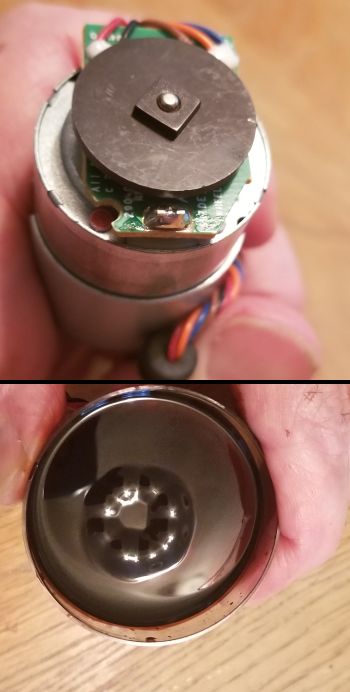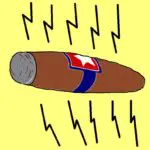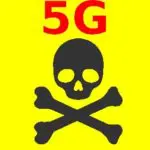A central concept in magnetism is the domain, discovered in 1906 by Pierre-Ernest Weiss. He theorized that in any magnetically permeable material, a large number of mostly microscopic regions existed as separate walled-off entities. In each of these entities, called domains, the atomic moments align in parallel when magnetized. But the alignment of individual domains is entirely random when the material is not magnetized.
Large domains are unstable and split into smaller domains until a lower limit on domain size is reached. When a split occurs, a new domain wall appears between adjacent domains. Here magnetic dipoles, or molecules with opposing magnetic polarity, form adjacently. This action aligns adjacent dipoles so they point in the same directions. (Forcing adjacent dipoles to point in different directions would require energy). Consequently, a domain wall requires extra energy which is proportional to the size of the wall. As the domains shrink, less net energy is saved by splitting, so soon a point of equilibrium is attained.
When magnetically permeable material gets magnetized, magnetization within each domain is in a uniform direction. The domains become aligned with each other in the presence of an exterior magnetic force. Applying an external magnetic field to the material causes the domain walls to actually move. Then, the field-aligned domains grow at the expense of the shrinking opposing domains. Removing the external magnetic field causes the domains aligned with the field to grow, while the others shrink. The domain walls maintain their alignment, producing a permanent magnetic field. Such a material can be demagnetized, however, via a technique called degaussing that subjects it to an oscillating magnetic field that is gradually reduced to zero. A permanent magnet can also be demagnetized by heating or hammering.

Patterns obtained via the Bitter technique provide no information about the magnitude or direction of the magnetization. But Bitter patterns can characterize the size and shape of domains present in materials having sufficiently large external fields. The resolution of the Bitter method depends somewhat on the size of the individual or agglomerated particles in the colloid. Fortunately there are several commercial suppliers of Bitter solution colloids, sometimes referred to as ferrofluids. Small amounts of this stuff is also available on Amazon. Bitter solution carrying sufficiently small particles can reveal magnetic structures down to the resolution limit of optical microscopes. Higher resolutions can be attained by using fine-grained sputter-deposited films for decoration.

The Bitter method does not separate magnetic from topographic contrasts. So samples are usually prepared by
polishing their surface flat, perhaps followed by chemical or electropolishing to remove residual surface strains.
As long as the magnetic particles remain in solution, the Bitter pattern depict the motion of domains and domain walls while applying a magnetic field. The ferrofluid may respond rather slowly, however, depending on the viscosity of the colloid. In some cases it may take several minutes for the Bitter pattern to come to complete equilibrium.

SEMs examine magnetic domains via one of two techniques. The first involves imaging low-energy secondary electrons ejected from the DUT. For optimization of image contrast, the primary beam energy is typically kept below 10 keV to produce the most secondary electrons. Image contrast depends on the geometry of the SEM’s electron detector relative to the DUT magnetic structure, so there is often some tilting and rotation of the sample to optimize contrast. Spatial resolution is limited typically to about 1 μm .
In the second SEM technique contrast arises from high energy, backscattered electrons. Image contrast relies on deflection of incident and backscattered electrons by magnetic fields within the DUT. The SEM must be equipped with a detector for backscattered electrons, a common SEM option. In operation, the DUT is tilted about 50° relative to the incident beam to maximize the beam energy. The technique requires relatively high primary beam currents, and spatial resolution is determined both by the size of the primary beam and by the escape volume of the backscattered electrons. Resolution varies from about 1 μm at lower energies to about 2 μm at 200 keV. The main benefit of this technique is that it can image domains somewhat below the surface of the DUT. At 200 keV, the electrons penetrate about 15 μm of material, helpful for magnetization depth profiling.
There are a few other methods used for examining magnetic domains. Domains 25 to 100 μm in size are imaged by means of Kerr microscopy. This technique uses the magneto-optic effect where polarized light rotates as it reflects off a magnetized sample. Lorentz microscopy displays magnetic domains at high resolution via a transmission electron microscope (TEM). Here electrons passing through a ferromagnetic material undergo a Lorentz force that depends on the magnetization direction and deflects them in different directions. A similar method is off-axis electron holography which involves the formation of an interference pattern in a TEM by overlapping two parts of an electron wave, one of which has passed through a region of interest on a specimen, the other a reference wave. Finally, magnetic force microscopy uses a super-small probe tip that is magnetically coated to scan the surface of a DUT.






Leave a Reply
You must be logged in to post a comment.